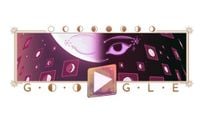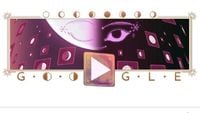On April 24, 2025, Google delighted users with an interactive doodle celebrating the "half moon" of April, specifically the waning quarter moon. This doodle, which appears on the main search page, allows users to engage in a fun game while learning about the various phases of the moon. The game not only entertains but also educates players about lunar science, making it a unique blend of learning and enjoyment.
According to NASA, a lunar month lasts approximately 29.53 days, during which the moon transitions through all its phases. This month, users can enjoy a minigame that has previously appeared between October and December of last year and again from January to March of 2025. The doodle invites players to explore the lunar phases through an engaging card game format.
The game mechanics are reminiscent of tic-tac-toe, where players must match cards representing lunar phases to score points. Players can also "steal" cards from their opponent by adding another card, enhancing the strategic element of the game. The objective is to advance through three levels of increasing difficulty, with each correct match earning points and unlocking new cards.
Google's doodle is available worldwide, with the exception of certain regions in Asia and North America. This accessibility ensures that a broad audience can participate in the lunar celebration. The game's educational aspect is significant, as it teaches players about the different lunar phases, including the new moon, crescent moon, first quarter, gibbous waxing, full moon, gibbous waning, last quarter, and waning moon.
The doodle also serves a cultural purpose, celebrating the half moon, which holds symbolic significance in various cultures. The half moon, which occurs when the moon is 50% illuminated, marks a crucial point in the lunar cycle. In many cultures, this phase signifies the passage of time in lunar calendars, particularly in the Islamic calendar, where it denotes the beginning of a new month. Additionally, it is often associated with themes of renewal, introspection, and spiritual connection.
When users click on the doodle, they are taken to a vibrant animated display showcasing a half moon rising in the night sky, surrounded by stars and natural elements. This visual representation not only captures the beauty of the night sky but also evokes a sense of wonder and curiosity about the universe.
Google has a long history of creating doodles to commemorate significant events and phenomena. The first doodle was designed in 1998 by Google founders Larry Page and Sergey Brin to celebrate the Burning Man festival. Since then, these playful and often interactive designs have evolved, becoming a beloved feature of the search engine.
As users engage with the doodle, they are encouraged to explore the scientific and cultural perspectives of the crescent moon. This exploration is facilitated by the doodle's interactive nature, which allows players to learn while they play. The game not only tests memory and knowledge but also promotes curiosity about astronomy and the natural world.
The interactive doodle for the half moon of April stands out for its educational value and entertainment. By merging gameplay with scientific learning, Google effectively captures the attention of users of all ages. The game's format is designed for easy access; players can simply visit the Google homepage and click on the doodle to start playing without any downloads or installations required.
In addition to providing entertainment and education, Google's doodles highlight the company's commitment to promoting cultural diversity and knowledge. By celebrating astronomical phenomena like the half moon, Google reinforces its role as not just a search engine but also as a platform for learning and exploration.
Overall, the half moon doodle represents a successful blend of fun, education, and cultural significance, inviting users to engage with the wonders of the lunar cycle in an accessible way. As the game unfolds, players are reminded of the beauty and mystery of the night sky, fostering a deeper appreciation for the celestial events that shape our world.
As Google continues to innovate with its doodles, users can look forward to more interactive experiences that celebrate important events and phenomena. The half moon game is just one example of how technology can enhance our understanding of the universe while providing delightful entertainment.
In conclusion, the April 24, 2025, doodle is a testament to Google's ability to create engaging and educational content that resonates with users. By combining fun gameplay with scientific learning, the doodle not only celebrates the half moon but also inspires curiosity about the cosmos.






